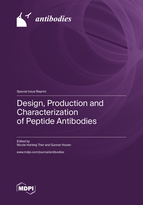Design, Production and Characterization of Peptide Antibodies
A special issue of Antibodies (ISSN 2073-4468).
Deadline for manuscript submissions: closed (20 May 2021) | Viewed by 46435
Special Issue Editors
Interests: antibody selection; peptide antibodies; modification-specific antibodies; mutation-specific antibodies; monoclonal antibody; synthetic resin-bound peptides; antibody; autoantibodies; Hu paraneoplastic encephalomyelitis antigens reactivity; primary Sjögren’s syndrome; antibody reactivity; antibody production; polyclonal antibody; rheumatoid arthritis; immunoassays
Special Issues, Collections and Topics in MDPI journals
Interests: antibodies; aptamers; peptides; peptide antibodies; recognition molecules; synthetic libraries
Special Issues, Collections and Topics in MDPI journals
Special Issue Information
Dear Colleagues,
Antibodies are key reagents in diagnostics and experimental biology, capable of detecting numerous antigenic targets. Proteins are often in focus and are usually effective targets for antibody production. Occasionally, however, the native protein is known but not available, or a very specific target is required. In these cases, synthetic peptides, copying essential sequences from the target, are good alternatives for antibody production. Peptide antibodies have been used in diagnostics and experimental biology with great success, especially because they can be produced to multiple targets, for example, native and denatured targets: In particular, mutation-specific antibodies have become important as diagnostic tools in malignant and premalignant conditions. Thus, peptide antibodies have become powerful tools and are readily produced to any peptide of choice, if appropriate precautions are taken.
When selecting or designing the peptide used for antibody production, critical elements (among others) include peptide length, structure, and amino acid composition, but elements such as peptide synthesis limitations and peptide antibody accessibility to the intended target are also critical for a good outcome.
Traditional peptide antibody proteins encompass animal-based immunization with a synthetic peptide, usually conjugated to a carrier protein to enhance immune presentation, as small peptides tend not to be immunogenic by themselves. There are several strategies for the conjugation of peptides to carriers applied for immunization. This is the most used approach for peptide antibody production. In addition to traditional peptide antibody production, peptide antibodies can be produced using libraries or sequencing.
Following peptide antibody production, newly generated peptide antibodies are typically characterized based on their reactivity in immunoassays (e.g., enzyme-linked immunosorbent assays or surface plasmon resonance), where antibody specificity and reactivity are determined.
This Special Issue “Design, Production and Characterization of Peptide Antibodies” aims to describe the current state-of-the-art techniques and characterization/applications within the field as well as newer and emerging uses of peptide antibodies.
Dr. Nicole Hartwig Trier
Prof. Gunnar Houen
Guest Editors
Manuscript Submission Information
Manuscripts should be submitted online at www.mdpi.com by registering and logging in to this website. Once you are registered, click here to go to the submission form. Manuscripts can be submitted until the deadline. All submissions that pass pre-check are peer-reviewed. Accepted papers will be published continuously in the journal (as soon as accepted) and will be listed together on the special issue website. Research articles, review articles as well as short communications are invited. For planned papers, a title and short abstract (about 100 words) can be sent to the Editorial Office for announcement on this website.
Submitted manuscripts should not have been published previously, nor be under consideration for publication elsewhere (except conference proceedings papers). All manuscripts are thoroughly refereed through a single-blind peer-review process. A guide for authors and other relevant information for submission of manuscripts is available on the Instructions for Authors page. Antibodies is an international peer-reviewed open access quarterly journal published by MDPI.
Please visit the Instructions for Authors page before submitting a manuscript. The Article Processing Charge (APC) for publication in this open access journal is 1800 CHF (Swiss Francs). Submitted papers should be well formatted and use good English. Authors may use MDPI's English editing service prior to publication or during author revisions.
Keywords
- Antibodies
- Antibody production
- Peptide antibodies
- Diagnostics
- Mutation-specific antibodies
- Critical elements, including peptide length
- Structure and amino acid composition







